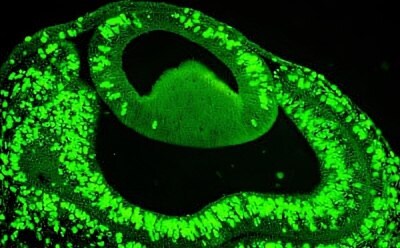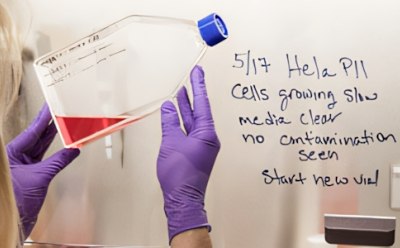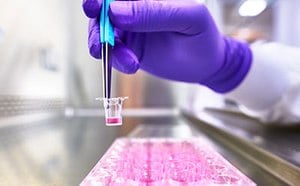Cell Growth & Maintenance

Cell culture is a fundamental technique used in life science research to establish relevant biological models or to produce recombinant proteins, virus particles, or biological therapies. Growth and maintenance of cultured cells like bacteria, yeast and mammalian cells is performed in a biosafety cabinet (often called a cell or tissue culture hood) using appropriate sterile technique to prevent microbial and chemical contamination.
Types of Cell Culture
Two of the most prominent approaches to mammalian cell culture are primary culture and continuous culture. Primary cultures are derived directly from human or animal tissue and have a lifespan in culture that is limited by cellular senescence. Continuous cultures are considered ‘immortal’ in culture, as they are often derived from patient cancer tissue. Cell lines may also be created by immortalizing cells and can be serially propagated or passaged for numerous cell division cycles, or indefinitely.
Featured Categories
Choose from a range of optimized cell culture media formulations, including DMEM, RPMI-1640, and serum-free options for diverse cellular needs.
Enhance cell culture with Millicell® inserts, plates, chamber slides, flasks. Achieve biologically relevant growth, choose hanging or standing inserts.
Browse high-quality cell culture supplements, including sera, growth factors, cytokines, hormones, and freezing reagents.
Rich in growth-promoting factors, Fetal bovine serum (FBS) or fetal calf serum (FCS) is an ideal supplement for mammalian cell culture.

Cells can be cultured in suspension or as a 2D monolayer that attaches to the tissue culture flask or multiwell plate. The culture method is determined by the cells’ tissue of origin; cells derived from blood generally grow in suspension, while those derived from solid tissues typically grow in monolayers.
3D cell culture models (organoids and spheroids) are generally considered to more closely mimic the cell’s in vivo environment than cells grown on 2D surfaces. Spheroids are often formed from cancer cell lines or tumor biopsies (patient-derived xenografts, or PDX) as free-floating cell aggregates in ultra-low attachment plates, while organoids are commonly derived from tissue stem cells embedded and then differentiated within an ECM hydrogel matrix.
Cell Growth Phases
Ensuring adequate cell growth is critical to collecting accurate data from cell culture studies. Cell counts can be determined using a hemocytometer or an automated cell counter, which offers more precise cell counts.
Cell growth in culture generally happens in four phases:
- Lag phase – Cells are adjusting to culture conditions and do not divide.
- Log (Logarithmic) Growth Phase – Cells are actively dividing, so this is the best stage during which to assess population growth or collect data. Late log phase is the best time to passage (subculture) cells.
- Plateau (Stationary) Phase – Growth slows as cells approach 100% confluence, and cells are most susceptible to stress or injury as cellular waste accumulates and resources are depleted.
- Decline Phase – The population of live cells declines as cell death predominates.
Cell Culture Media, Supplements and Reagents
Cultured cells require a supply of nutrients for growth. Mammalian cell culture media must maintain physiological pH, in addition to providing balanced salts, carbohydrates, amino acids, vitamins, fatty acids and lipids, proteins and peptides, trace elements, and growth factors. Fetal bovine serum (FBS) is the most widely used growth supplement for mammalian cell culture, as it contains many of these essential cellular nutrients and has been demonstrated to support the growth of cells and tissues in culture. For applications requiring defined media or reduced animal components, xeno-free media formulations provide animal-free formulations of known composition.
Because media and supplements often provide rich nutrients for growth of opportunistic microbes, successful cell culture requires aseptic technique and regular observation to ensure the absence of contaminants which can cause cell death or confound in vivo-like growth. For common microbial contaminants that cannot be observed microscopically, routine screening with mycoplasma detection reagents protects cultures and tissue propagation environments.
Yeast cultures, like S. cerevisiae and P. pastoris (Pichia), are commonly used in research for recombinant protein expression and gene function studies. Critical nutrients typically included in a yeast culture medium formulation are peptone, yeast extract, and dextrose or glucose.
Cell Passaging Tips and Tricks
Passaging cells is a fundamental step in general cell culture to maintain cell health and optimal cell growth. This tutorial explains the process of cell passaging, including the importance of confluency and cell density. The protocol for cell passaging involves processes such as monitoring and counting cells, trypsinization or dissociation of cells, and reseeding of the cells into new cultureware.
Cell culture environments and cultureware
Cultured cells are grown and handled using single-use, sterile plasticware, including tissue culture flasks and multiwell plates, serological pipettes, sterile bottle-top filters, and sterile syringe filters. Plastic tissue culture flasks and plates are usually treated to provide a hydrophilic surface to facilitate attachment for adherent cells. As an alternative to 2D surfaces, microporous membrane-based plates provide a more physiological growth environment for complex cell assays, such as cell migration, cell-cell communication and cell polarization.
Cultured cells must be maintained at the temperature and gaseous environment that recreates these parameters in the organism from which they are derived. Cultureware containing cells and media are typically maintained in incubation appliances that provide precise control of temperature and gas mixtures. However, small-scale benchtop incubation systems that employ microfluidics and facilitate imaging of cells in uninterrupted culture can provide the most authentic environments for predictive in vitro models.
Visit our document search for data sheets, certificates and technical documentation.
Related Articles
- Know when to use antibiotics to prevent bacterial or fungal, mycoplasma, or viral contamination in cell culture and find suitable antibiotics or other biological agents.
- Antibiotic kill curve is a dose response experiment in which mammalian cells are subjected to increasing amounts of selection antibiotic
- Poly-Lysine enhances cell binding with positively-charged surface ions, optimizing electrostatic interaction on culture surfaces for increased cell attachment.
- Cell Culture Freezing Tips - Are you following best practices for cryostorage? We have cool tips for protecting your cells.
- Experimental studies measuring cell proliferation have had implications in cancer biology, immunology, cell biology, and developmental biology.
- See All (18)
Related Protocols
- Cryopreservation affects post-thaw recovery, viability, and functionality. Stress during freezing and suboptimal media lead to cell death.
- Dilute fibronectin for cell attachment, varying per cell type. Coating protocol, products, and FAQs provided.
- Discover our collection of primary human hepatic Kupffer cells and protocol for thawing, plating, and growing Kupffer cells. Find the formulation for Kupffer culture maintenance media.
- Discover our collection of primary human hepatic sinusoidal endothelial cells, a protocol for thawing, plating, and growing HHSECs, and a recipe for our HHSEC maintenance media formulation.
- Discover our primary human hepatocytes and plating and maintenance media formulations. Explore our protocol for plateable primary hepatocyte cell culture.
- See All (6)
Find More Articles and Protocols
How Can We Help
In case of any questions, please submit a customer support request
or talk to our customer service team:
Email custserv@sial.com
or call +1 (800) 244-1173
Additional Support
- Chromatogram Search
Use the Chromatogram Search to identify unknown compounds in your sample.
- Calculators & Apps
Web Toolbox - science research tools and resources for analytical chemistry, life science, chemical synthesis and materials science.
- Customer Support Request
Customer support including help with orders, products, accounts, and website technical issues.
- FAQ
Explore our Frequently Asked Questions for answers to commonly asked questions about our products and services.
To continue reading please sign in or create an account.
Don't Have An Account?



